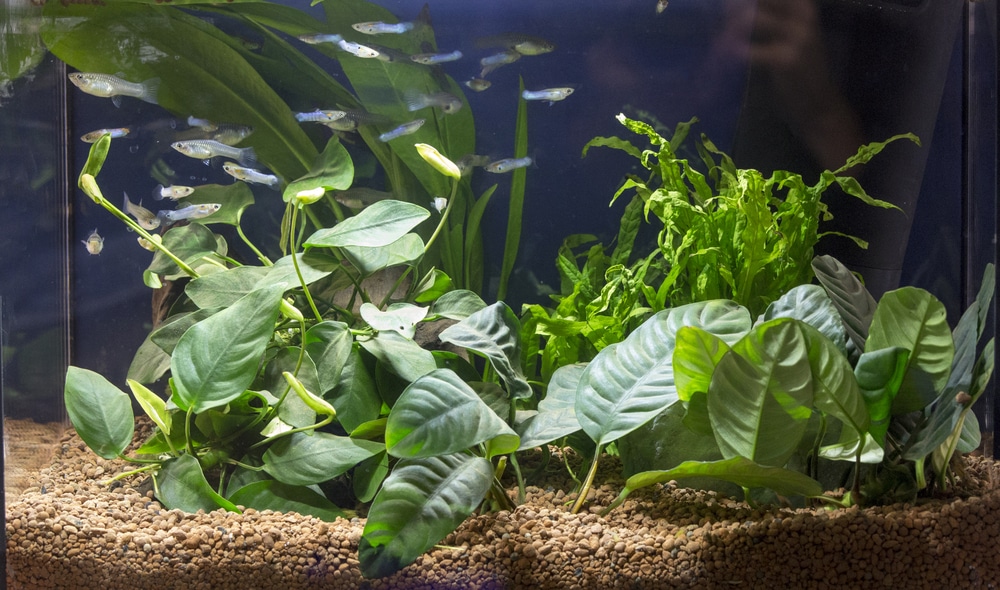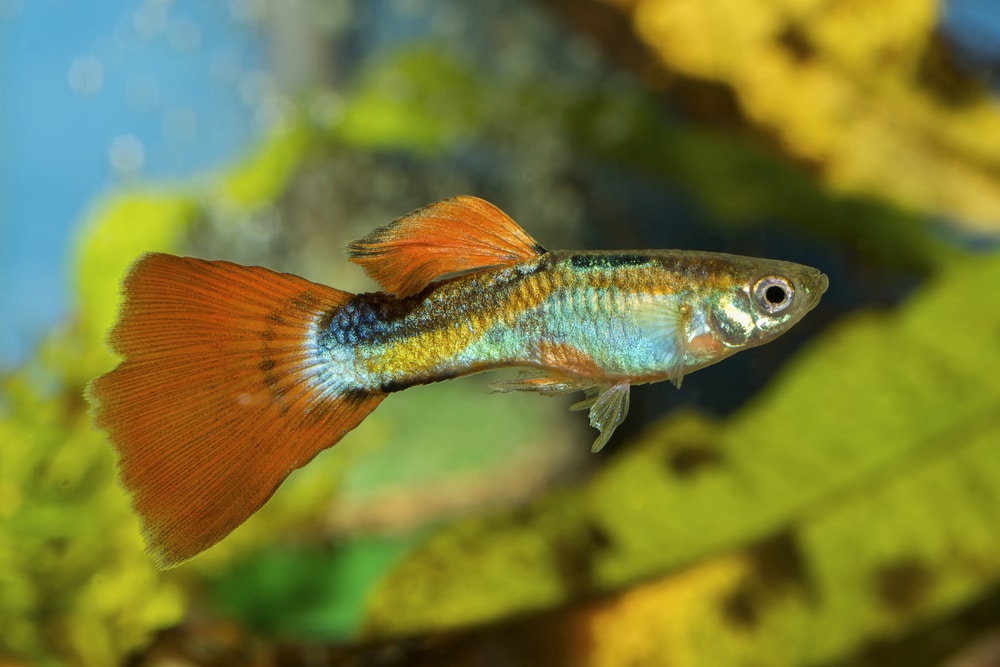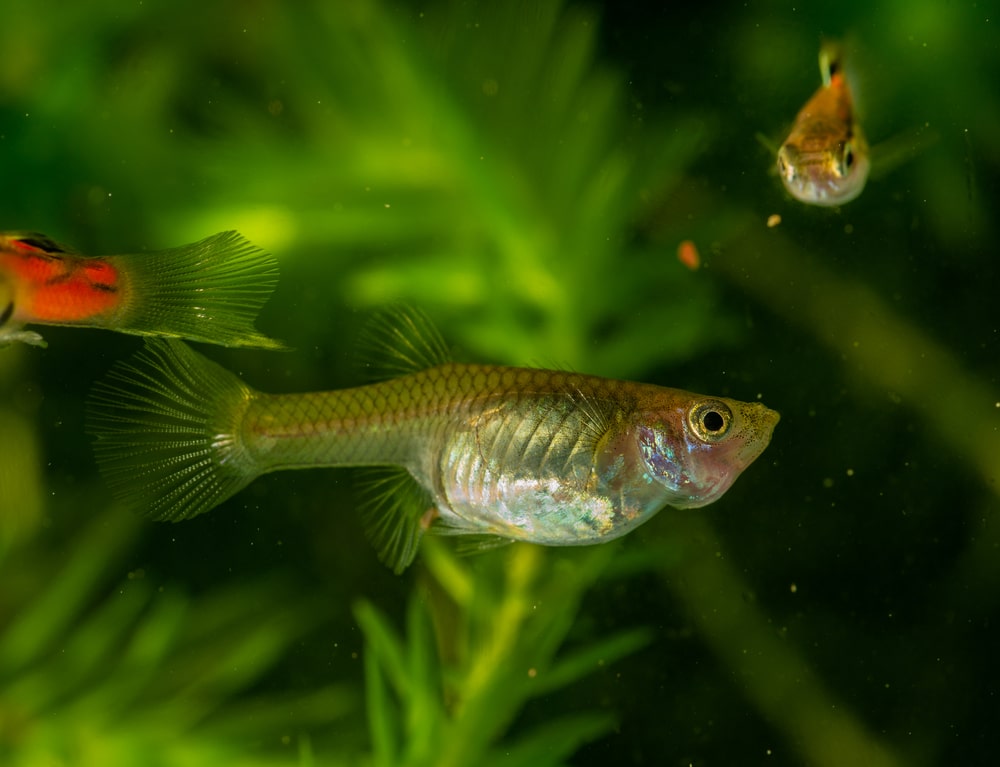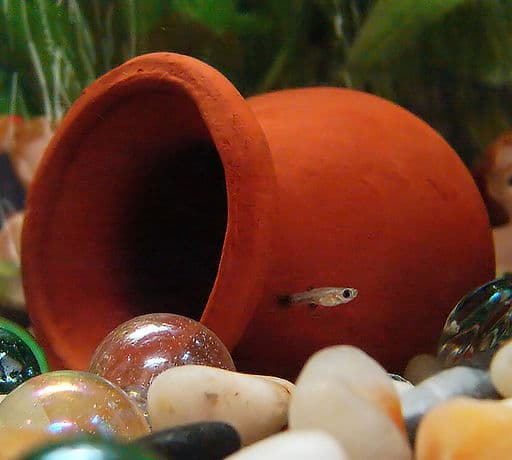Breeding any fish comes with its own unique opportunities and challenges – and the guppy is no exception.
While generally heralded as a beginner fish, there are some more delicate and beautiful strains that should only be kept and bred by very experienced aquarists.
Two of the biggest problems with breeding guppies are bent spines and too many fry. Improper water parameters cause both the mothers and fry to develop severely bent and curved spines.
In addition, once they start breeding, it is often impossible to get them to stop.
Even after they have been separated from a male for over 6 months, a female can still give birth every month.
In this article, we will teach you exactly how to breed guppies and raise fry the right way!
Setting up Your Guppy Breeding Tank

There are several issues to consider when setting up your breeding tank – one most important being “What do I plan on doing with the fry?”.
If you plan on keeping the fry in the same tank as the parents, the set up will be very different than if you plan on separating them as soon as they are born, or even using a breeder basket.
Either way, there will be a few similarities.
Tank Size & Filtration
The breeding tank should be at least ten gallons, though 20 gallons is recommended.
The filter should be a sponge filter or similar, as an uncovered H.O.B. (Hang on Back) or canister filter can kill fry. Sponge filters do not allow this to happen, but still provide essential filtration and flow.
We recommend the Aquaneat Sponge Filter below.
Substrate & Decorations
The substrate is entirely up to you, as guppies are fine on gravel, sand, bare bottom, or tile substrate.
Guppies often pick at the substrate for pieces of uneaten food, so be careful not to choose extremely fine gravel and remove all tiny rocks that come with normal gravel.
We also recommend providing several large decorations that females can escape and hide.
You will need at least 3-4 sight break decorations, or decorations that will break the line of sight between two fish.
Males constantly pursue and harass females (sometimes to death), so the females need to be able to get out of sight of the males.
Aside from this, the decorating is entirely up to you!
If you plan on trying to find the fry yourself and moving them to another tank, you will want to create fry traps, which we will discuss further.
If you do not, you should heavily plant the tank, providing several areas of tight knit plants, such as java moss, subwassertang, and guppy grass.
The parents will start hunting the fry as soon as they are born, but fry can escape into moss where the adults cannot follow them.
Water Parameters
Water parameters are some of the biggest issues that come along with guppies.
Since they are sold as starter fish, beginners often end up with them without knowing the proper care requirements.
While a beginner should know how to test ammonia, nitrite, and nitrate, it is unlikely that they also know how to test kH, gH, TDS, and salinity, all of which are very useful in keeping guppies.
Guppies need hard water in order to live, and that water needs to contain a large amount of calcium.
Since females are constantly giving birth to up to 30 fry every month, they need to be able to extract high amounts of calcium from the water.
Without adding calcium to the water, either with crushed coral or another source, their skeleton, and the skeletons of the fry, will become weak and warped.
The TDS, or total dissolved solids, measures the amount of minerals and other materials, such as salt, dissolved in the water.
However, it measures them all as one number, so you cannot determine what makes up those dissolved solids. The general hardness, or gH, is similar to the TDS, except it normally only measures the calcium and magnesium in the water.
With the kH, or carbonate hardness, you will be able to determine how much calcium is in the water. This is important for keeping guppies, and you will likely need to add a carbon supplement into the water.
Guppies prefer water that has between 15-30 gH and 8 or more kH.
It is better to keep on the mid to upper side of the gH measurements, though some of the hardier strains can survive a wider range.
The temperature should be between 78-82 degrees Fahrenheit, though a wider range is possible.
The pH should be on the higher end of 7 to the midrange of 8, though with a high gH and kH, you generally will not have to worry about the pH.
High Quality and What it Costs
When you first start looking into breeding any fish, buying a pair of $60 or $100+ fish may be tempting, especially for guppies.
Since they can have up to 30 babies monthly and sell for $20-200 each, it seems like you should easily be able to make money by breeding them, even for just one month.
Unfortunately, breeding guppies generally isn’t too profitable.
The reason that people can charge excessive amounts for a single fish is due to their rarity. They are often very delicate strains with high fry mortality rates, so breeding them is not as easy as breeding other guppies.
The sensitives range from strain to strain, such as the albinos being generally weak but also having eyesight problems, something you wouldn’t see in a green delta guppy, or a pet store mutt.
It is best to begin by breeding a stronger strain so that you get a feel for it, then moving up in complexity.
Sensitive strains are delicate due to inbreeding. Selective breeding often requires inbreeding, and without it, we wouldn’t have all the color variants we do today. However, the stronger the strain or coloration, the weaker the blood.
Genetic differences exist between all animals, both weaknesses and strengths. Bringing in new blood to a strain is important, because without adding in strengths, you will eventually only deal with weaknesses.
Closely related animals are more likely to have bad recessive traits, some of which can be lethal. These traits do not often show up, as the offspring would need one of the rare traits from the father and one from the mother.
When you inbreed animals, you are increasing the risk of these damaging recessive traits manifesting in the offspring.
So, while they may seem like a wonderful investment, they normally have very low survival rates. Unless you are very experienced in breeding guppies, starting out with a high-quality strain is a poor choice.
Getting the Breeders
Once you set up and cycle your tank (when 4ppm ammonia is processed into nitrate within 24 hours), you are ready to pick your breeders!
Male to Female Ratios
When picking out guppies to breed, you never want to pick one male and one female. The single male will harass the female to death.
When choosing your fish, you need a specific number of males and females. Males have what is called a gonopodium; a long and thin looking structure where the anal fin of a fish normally is.

Males have stronger and brighter coloration on the fins than females and will exhibit strong body coloration as well.
Females have triangular shaped anal fin, normally lack all color on the body, and will have dimmer coloration on the fins. It is normally extremely easy to differentiate between the two sexes.

For a ten gallon, it is best to start with one male and two to three females.
The type and strain you get is entirely up to you, but you need to ensure that there is a market already available for your particular strain.
Some strains, and mixes, are already too common, and you won’t be able to sell a single one.
Qualities to Look Out For
Pick guppies with bright eyes, intact fins, and bright coloration.
Guppies with fin rot may be experiencing shock from being moved from brackish to fresh water and are likely going to decline in health.
Most guppies are bred overseas in brackish water and moved to freshwater when transported to other countries.
For some guppies, this gets rid of infections that live in brackish water, but it shocks other guppies, resulting in illness.
Getting Started in Breeding Guppies
In terms of the difficulty of breeding guppies, or nearly any livebearer, it couldn’t be any easier.
When you put a male and female together (even for just one day) the female will regularly give birth for several months to over a year.
This can present an issue, as if your female was already in contact with another male before coming into contact with the male you picked for her, the babies can be from either male.
This can dilute the genes you wanted to breed, but sometimes you will end up with a surprise guppy close to show quality.
As long as you provide at least some cover for the babies, most will survive.
As previously mentioned, you need more females than males, preferably 3 females for every male. If you follow these two simple rules, along with keeping proper water parameters, you will have success breeding guppies.
However, if the strain you picked suddenly declines in popularity and you are unable to sell any guppies, you need to separate the male and female fry as soon as possible. This will prevent further breeding.
You can try and offer plants along with guppies to make sales or use the guppies for something else. The only way you can guarantee that a feeder fish is healthy is if you bred it yourself.
Breeding Baskets
Breeding baskets, breeding nets, and breeding boxes are the center of debate among livebearer breeders. Some swear that it is the only way they are able to save any fry, while others say the boxes stress the females enough to abort the babies, then die of stress themselves.
If you plan on using a breeding basket, be aware that moving a female close to giving birth can stress her enough to abort the fry.
In addition, if she is stressed for too long, the stress of being moved to a confined place coupled with the stress of giving birth can kill her.
If you want to use a commercial breeder basket, net, or box, it is best to simply move fry into them after they are born.
On the other hand, if you want to move the female into a separate area to give birth, the best way to do this is with a diy breeder basket.
A five-gallon pail strainer, something that you should be able to find in most hardware stores, functions as a great breeder box. It allows water movement through the bottom and is not a confined space like most other breeding baskets.
Get one of these and rest it on the rim of the tank, or tape it if necessary. Fill it with mosses and floating plants with long roots, as these will allow the babies to hide in a way that the mom can not get to them.
Not only will other adults try to eat the fry, but the mom will as well. This is why a separate breeding container can come in handy.
Whether you choose to use a breeding basket or not is up to you but be advised that using a commercial breeding basket to house heavily pregnant female guppies can result in the death of the fry and the parent.
Fry Traps
Aside from using a breeder basket or plant cover to prevent the fry from being eaten, you can also use fry traps.
These trap the fry or remove them to safe areas of the tank, which will be easier than trying to gather them in a net and move them.
The easiest trap is simply plants; make a ball of moss or guppy grass, and after the fry have been born, they will immediately search for safety and go to the plants.
Once most of the fry are in the plants, scoop them out with a net and place them either in a divided section of the tank or a different tank.
If you place them in a different tank, the water must be perfectly identical to the other in terms of temperature, hardness, and pH.
Needlepoint plastic canvas is something that you can find in most craft stores, and doubles as a trap and a hiding area.
Small, newborn fry can fit between the gaps in this canvas, so if you make a dome, tube, cube, or divider out of it, they will go inside to hide.
However, as they start to grow, they will be unable to go back out of the canvas, which protects them from the adults.
The adults have no possible way of getting through to fry once they have passed through the canvas, unless they go back out.
Raising the Fry

Unlike most other fish, raising average guppy fry is very simple.
Because Guppy fry have such high survival rates, most people actually end up with a guppy overpopulation problem instead of an absence of fry.
However, some of the more delicate strains will have high fry mortality rates, and unfortunately, there’s not much you can do to save them.
Aside from that, livebearer fry are normally easy to raise due to the fact that they will take prepared food immediately, without the need for any live food or training. Crushed flakes and pellets are fine for guppies, but powdered fry food and other fry foods are also acceptable. They are not at all picky.
If you have had your adult guppies for less than a month and are experiencing a high fry mortality rate from a common and hardy strain, you may be dealing with a bacterial or parasitic infection.
Watch the adults for any signs of infection, whether it be abnormally small bellies or slight tufts of white on them.
A broad-spectrum antibiotic or antiparasitic medication can be used on the fry and adults if you spot any symptoms.
Many medications state whether or not they are fry safe, but you can always call or email the producing company to ask.
Shipping and Selling Fry
Knowing when you can and cannot sell your fry is vital to their survival and your sales.
If you are selling them to your neighbor next door, you can sell them when they are just a few weeks old. Similarly, if they are being sold at an aquarium club that is a short drive away, they can be younger than ones you have to ship through the mail.
People will not buy colorless fry from unproven parents.
If you have proven show quality fry, then people will buy some of the colorless fry, but these fry generally will not survive a shipment journey.
Once they have developed their full colors and the males have sexed out (normally 1-3 months of age), you can ship and sell them anywhere.
Normal strains of guppies ship well and normally arrive with good coloration.
Some of the more sensitive strains do not ship well, and often die during transit or arrive with limited coloration. It often takes them several days to several weeks to fully recover.
When shipping guppies, there are two main methods you can use; either breather bags or poly bags.
For both methods, you will need a cardboard box, Styrofoam insulation that will fit to the sides of that box, padding, and a heat pack. For breather bags, you will need a bar heat sealer.
For poly bags, you will need those either rubber bands, zip ties, or something else to secure it, which could be a heat sealer.
Poly bags are the standard way to ship fish; fill the bag ¼-1/3 of the way full with water. Ensure that the fish will be covered with water no matter which way the bag tips.
The air inside the bag will be all that they have to breathe for the duration of transport, but if you used an appropriately sized bag, it will last 3-5 days.
The initial poly bag should be securely shut, then double or triple bagged to prevent spillage.
For a breather bag, you can fill the entire thing with water. This will prevent the fish from being sloshed around and prevent stress, which is ideal for the more sensitive strains.
Simply heat seal the bag once full and filled, and you’re good. The bag allows a constant flow of oxygen and carbon dioxide in and out of the bag, so the fish will not suffocate within it.
You must first place the insulation inside of the box, which should cover every side. Leave the top off for now. Fill the box with padding/packing materials, then gently place the bag(s) of fish inside where they will be secure. Remember the box will be bouncing along on trucks, conveyer belts, and possibly airplanes.
Next, activate the heat pack, loosely wrap it in paper, and tape it to the underside of the insulation lid.
Heat packs keep the water temperature close to tropical levels, which will lower the amount of stress your guppies will experience. After that, simply wrap up the box and treat it as a normal fragile package.
In conclusion, breeding guppies is a simple task. You must ensure that the water parameters are appropriate and that you have a good sex ratio.
Separating the fry from the parents is the most difficult part, but even that is relatively easy. Guppies are a great fish for a beginning breeder to start out with, as the fry are not fussy, and there is no coaxing necessary to get the adults to breed.
Conclusion
Breeding Guppies can be an engaging and rewarding experience. In fact, Guppies are one of the first fish that I ever successfully bred and raised from from fry.
Because of their hardy nature, guppies are the perfect species for fishkeepers looking to get started in fish breeding.
This guide should contain everything you need to know about how to breed guppies. Feel free to reach out or leave a comment below with any questions!


I love this article it was so helpful